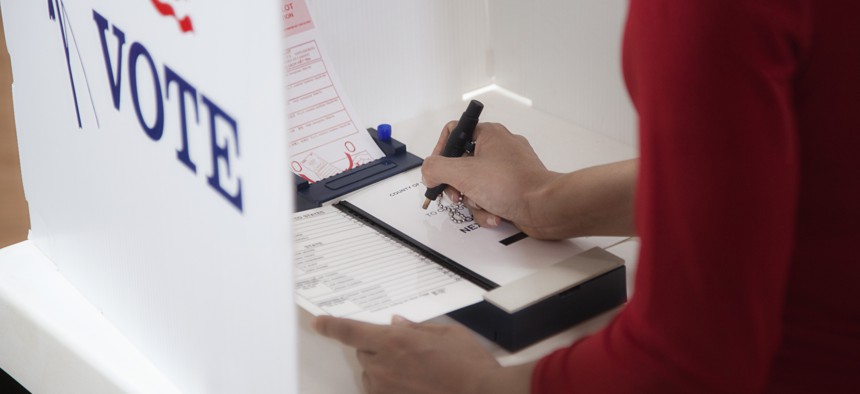New data tracks polling place locations for 37 states

GettyImages/ Hill Street Studios
The dataset can be used to study changes made by state and local election officials in response to the COVID-19 pandemic and new laws overhauling ballot access.
The Center for Public Integrity is releasing a dataset of polling place locations used in the 2020 general election to help journalists and researchers analyze access to the ballot box and the potential effects of a slew of changes to state election laws.
The data expands an earlier release from the Center for Public Integrity and Stateline last year that included polling place locations and addresses for 30 states for the 2012, 2014, 2016 and 2018 general elections.
The new data release, available via Github, includes polling place locations and addresses for the 2020 general election in 37 states. This new dataset, along with the data from earlier elections, can be used to study changes made by state and local election officials in response to the COVID-19 pandemic and a series of new laws overhauling ballot access around the country. The Center for Public Integrity will continue to update this dataset with information from more states in the upcoming months.
The data for the earlier release from Stateline and the Center for Public Integrity was gathered as part of an investigative project, Barriers to the Ballot Box, that examined the impact of the movement and closure of polling places in states including Louisiana and North Carolina. The project was a finalist for the 2021 Toner Prize for Excellence in National Political Reporting.
No public national dataset of polling place locations used in past elections existed previously. Polling place locations are locally controlled, so assembling the data, both for 2020 and previous years, required submitting more than 1,000 public records requests to states and counties.
“The challenge with this data has always been that to do anything systematic requires compiling the data from lots and lots of different sources,” said Nick Eubank, an assistant research professor at the Duke Social Science Research Institute who has studied the effects of polling place changes on political participation.
Eubank now is working with students on a project using the data to study access to polling places on college campuses, and said having the data in one place “is just an unbelievably valuable resource.”
The pandemic last year forced seismic changes to the ways in which Americans cast ballots. Journalists, researchers and advocates for voting rights continue to use the polling place location data to determine which voters were affected by the closure, movement and change of polling places.
In addition to the Center for Public Integrity and Stateline, the data was used in reporting by news organizations including The New York Times, the Wall Street Journal, NPR and Iowa Public Radio and Wisconsin Watch. Reporting stemming from the data has been cited in testimony at congressional hearings and in reports by nonprofit groups that advocate for voting access, including the Brennan Center for Justice at New York University School of Law, the Voting Rights Lab and the Stanford-MIT Healthy Elections Project.
The nonprofit Center for New Data used the polling place locations, together with smartphone location data, for widely cited analysis of voter wait times in Georgia and the potential effects of changes there.
The Center for Public Integrity and Georgia Public Broadcasting used that data earlier this year to report on how proposed changes to voting laws would affect communities of color.
“Being able to understand exactly where they are and how they’re being moved is equally, if not more, important than just knowing the total number in a given jurisdiction,” said Kevin Morris, a researcher for the nonpartisan Brennan Center for Justice at New York University School of Law currently using the data to look at the effect of locating polling places at police stations. The data “is helping to reveal that there are actual costs that are faced by voters in terms of traveling to their polling places.”
That’s something civil rights and voting rights advocates have long voiced concern about. In a 2013 decision, Shelby County v. Holder, the U.S. Supreme Court struck down a key part of the Voting Rights Act, eliminating the requirement that places with a history of racial discrimination in voting seek approval from the Department of Justice before making changes to voting procedures, including to polling place locations.
Since then, jurisdictions have closed thousands of polling places. But the reasons for the changes vary widely, with some places increasing their use of regional vote centers over neighborhood polling places and growing the use of vote by mail.
Every polling place closure isn’t necessarily nefarious, but it’s important to look at the justification for the closure and the effect of rapidly changing state laws that may limit access to alternatives such as vote by mail, said Jesselyn McCurdy, executive vice president of government affairs for the Leadership Conference on Civil and Human Rights, a coalition of more than 200 civil rights groups. In 2019, the group released a report drawing attention to declining numbers of in-person polling places in jurisdictions previously covered by the Voting Rights Act requirement to seek federal approval for changes.
“Have they now changed the law where it’s more difficult to vote by mail, and they’re closing polls?” she asked.
This article was first posted to Stateline, an initiative of The Pew Charitable Trusts.





